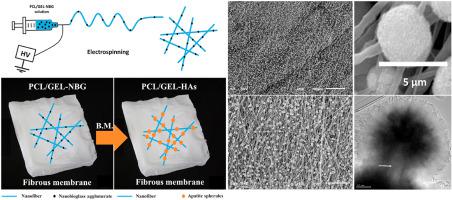Ceramics International ( IF 5.1 ) Pub Date : 2021-04-07 , DOI: 10.1016/j.ceramint.2021.04.003 Ahmed El-Fiqi , Hae-Won Kim

|
Bioactive and biodegradable fibrous membranes are highly attractive for periodontal bone regeneration. Herein, we demonstrate a new approach for fabrication of a novel nano/micro-structured fibrous membrane made of biodegradable poly(ϵ-caprolactone)/gelatin (PCL/GEL) nanofibers and biomemtically-grown hydroxyapatite spherules (HAs). The proposed approach includes electrospinning fabrication of PCL/GEL nanofibers containing nanobioglass (NBG) agglomerates and their biomimetic transformation into HAs. The NBG agglomerates (~1.9 μm in diameter) enabled the growth of biomimetic HAs (~4 μm in diameter) around the PCL/GEL nanofibers and generated a unique nano/micro-structure. Interestingly, the biomimetically-grown HAs imparted the PCL/GEL-HAs nanofibrous membrane with several remarkable properties including nano/micro-topography, bone-mimetic composition (Ca/P = 1.60), large specific surface area (~31 m2/g), high protein adsorption capacity (~157 μg protein/mg membrane) and controlled protein delivery with zero-order release kinetics; along with sustained release of therapeutic ions (Ca2+ ~ 37 ppm, PO43− ~ 24 ppm, and SiO44− ~ 61 ppm). Furthermore, the PCL/GEL-HAs membrane exhibited enhanced wettability, good biodegradability and adequate mechanical properties. Collectively, the PCL/GEL-HAs demonstrated unique properties and it can be considered as a novel multifunctional bioactive/biodegradable membrane for periodontal bone regeneration.
中文翻译:

具有仿生生长羟基磷灰石小球的纳米/微结构聚(ε-己内酯)/明胶纳米纤维:高蛋白质吸附、受控蛋白质递送和持续生物活性离子释放设计为多功能骨再生膜
生物活性和可生物降解的纤维膜对牙周骨再生非常有吸引力。在此,我们展示了一种制造新型纳米/微结构纤维膜的新方法,该纤维膜由可生物降解的聚(ε-己内酯)/明胶(PCL/GEL)纳米纤维和生物仿生生长的羟基磷灰石球粒(HA)制成。所提出的方法包括静电纺丝制造含有纳米生物玻璃 (NBG) 团聚体的 PCL/GEL 纳米纤维及其向 HA 的仿生转化。NBG 附聚物(直径约 1.9 微米)使仿生 HA(直径约 4 微米)在 PCL/GEL 纳米纤维周围生长,并产生独特的纳米/微米结构。有趣的是,仿生生长的 HAs 赋予了 PCL/GEL-HAs 纳米纤维膜几个显着的特性,包括纳米/微形貌,2 /g)、高蛋白质吸附能力(~157 μg 蛋白质/mg 膜)和控制蛋白质递送,具有零级释放动力学;随着治疗离子的持续释放(Ca 2+ ~ 37 ppm、PO 4 3− ~ 24 ppm 和 SiO 4 4− ~ 61 ppm)。此外,PCL/GEL-HAs 膜表现出增强的润湿性、良好的生物降解性和足够的机械性能。总的来说,PCL/GEL-HAs 表现出独特的特性,它可以被认为是一种用于牙周骨再生的新型多功能生物活性/可生物降解膜。















































 京公网安备 11010802027423号
京公网安备 11010802027423号